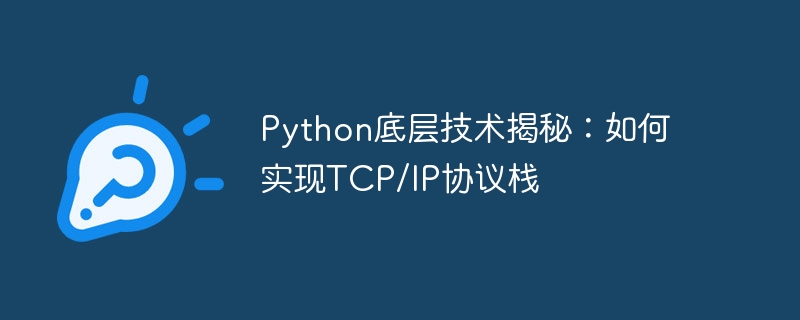Home >Backend Development >Python Tutorial >Python underlying technology revealed: how to implement the TCP/IP protocol stack
Python underlying technology revealed: how to implement the TCP/IP protocol stack
- PHPzOriginal
- 2023-11-08 11:21:26901browse

Revealing the underlying technology of Python: How to implement the TCP/IP protocol stack requires specific code examples
Introduction:
With the rapid development of the Internet, TCP/IP The protocol has become one of the most important protocols in the modern Internet. For developers who want to deeply understand the underlying principles of network communication, understanding the implementation principles of the TCP/IP protocol stack will be very valuable knowledge. This article will delve into the implementation process of the TCP/IP protocol stack and how to use Python language to implement a simple TCP/IP protocol stack.
1. Introduction to TCP/IP protocol stack
TCP/IP protocol stack refers to a set of protocols in network communication, which includes TCP and UDP protocols at the transport layer and IP protocols at the network layer. The TCP/IP protocol stack is responsible for transmitting and routing data in the network and providing reliable data transmission services. Implementing the TCP/IP protocol stack can give us a deeper understanding of the underlying principles of network communication.
2. Implementation Principle of TCP/IP Protocol Stack
To implement a TCP/IP protocol stack, we need to first understand the working principle of the TCP/IP protocol stack. The main functions of the TCP/IP protocol stack include data encapsulation and decapsulation, data segmentation and reassembly, data transmission and confirmation, error control and flow control, etc.
- Encapsulation and decapsulation of data
When an application wants to send data, the TCP protocol is responsible for encapsulating the data into one or more TCP segments and passing them to the IP protocol. The IP protocol further encapsulates TCP data and adds information such as source IP address and destination IP address. After the data is encapsulated into a TCP/IP packet, it can be transmitted through the network. On the receiving end, the IP protocol is responsible for decapsulating the data and passing it to the TCP protocol for processing. - Data segmentation and reassembly
In order to adapt to the transmission capabilities and transmission quality of different networks, the TCP protocol will divide larger data segments into multiple small TCP segments for transmission. At the receiving end, the TCP protocol reassembles the received TCP segments to restore the original data. - Data transmission and confirmation
TCP protocol uses a reliable data transmission mechanism to ensure accurate data transmission. Each TCP segment is accompanied by a sequence number to ensure the correct transmission order of data. The receiving end will sort and confirm the received TCP segments, and send a confirmation message to the sending end to ensure reliable transmission of data. - Error control and flow control
The TCP protocol implements error control through the use of checksums and retransmission mechanisms. The checksum is used to detect whether the data has been modified or lost, while the retransmission mechanism can resend the data if it is lost. In addition, the TCP protocol also uses a sliding window mechanism for flow control to prevent the sender from sending too much data that the receiver cannot process.
3. Sample code for implementing TCP/IP protocol stack in Python
Now we will use Python language to implement a simple TCP/IP protocol stack. The following is a sample code:
import socket
def send_tcp_packet(data, dest_ip, dest_port):
# 创建一个TCP socket
s = socket.socket(socket.AF_INET, socket.SOCK_STREAM)
# 连接目标IP和端口
s.connect((dest_ip, dest_port))
# 发送数据
s.send(data)
# 关闭连接
s.close()
def receive_tcp_packet():
# 创建一个TCP socket
s = socket.socket(socket.AF_INET, socket.SOCK_STREAM)
# 绑定本地IP和端口
s.bind(('localhost', 8888))
# 监听并接受连接
s.listen(1)
conn, addr = s.accept()
# 接收数据
data = conn.recv(1024)
# 关闭连接
conn.close()
return data
def main():
# 要发送的数据
data = b'Hello, world!'
# 目标IP地址和端口
dest_ip = '127.0.0.1'
dest_port = 8888
# 发送数据
send_tcp_packet(data, dest_ip, dest_port)
print('Data sent successfully!')
# 接收数据
received_data = receive_tcp_packet()
print('Received data:', received_data)
if __name__ == '__main__':
main()The above code implements a simple TCP/IP protocol stack, in which the send_tcp_packet function is used to send TCP data packets, and the receive_tcp_packet function Used to receive TCP packets. In the main function, we can set the data to be sent, the target IP address and port, and send the data by calling the send_tcp_packet function, and call receive_tcp_packet## on the receiving end. #Function to receive data.
This article introduces the working principle of the TCP/IP protocol stack and provides a sample code for implementing the TCP/IP protocol stack using Python language. By in-depth understanding of the implementation principles of the TCP/IP protocol stack, we can better understand the underlying principles of network communication and improve our understanding and development capabilities of network programming. I hope this article is helpful to you, thank you for reading!
The above is the detailed content of Python underlying technology revealed: how to implement the TCP/IP protocol stack. For more information, please follow other related articles on the PHP Chinese website!

